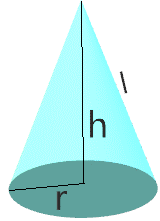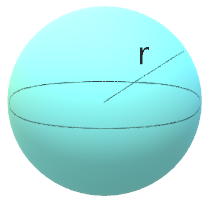Surface Area
The Surface Area of a 3D shape is the sum of the areas of each face. Surface area is also measured in square units such as square centimeters (\(\text{cm}^2\) ), square inches ( \(\text{in}^2\) ) etc..
Surface Area of Common Shapes
Let's look at how to calculate the surface area of the shapes below:
Cube

The surface area of a cube with side length \(s\) is calculated as:
\(SA = 6 s^2\)
Cuboid

The surface area of a cuboid (rectangular prism) with length \(l\), width \(w\) and height \(h\) is calculated as:
\(SA = 2 (l w + l h + w h)\)
Cone

The surface area of a cone with height \(h\), slant \(l\), and radius \(r\) is calculated as:
\(SA = \pi r (l + r)\)
Cylinder

The surface area of a cylinder with radius \(r\) and height \(h\) is calculated as:
\(SA = 2 \pi r (h + r)\)
Triangular Prism

The surface area of a triangular prism with two equal side lengths \(s\), base \(b\), height \(h\) and length \(l\) is calculated as:
\(SA = bh + 2ls + lb\)
Sphere

The surface area of a sphere with radius \(r\) is calculated as:
\(SA = 4 \pi r^2 \)
Surface Area Using Nets
The Net of a 3D shape is formed when the shape is unfolded along its edges and its faces are laid out in a pattern in 2D. Nets are helpful to visualize the different faces of a 3D object to calculate the surface area.
Let's draw a net for the prism below.

We have to unfold the 3D object to get the net shape below:

You can see that the original 3D shape is made up of 6 rectangles. We can calculate the area of each using \(A = lw\). Lastly, we add them all up to get the surface area.
\(SA_{\text{prism}} = (2)(6) + (3)(6) + (2)(6) + (3)(6) + (3)(2) + (3)(2) \)
\(SA_{\text{prism}} = 2 ( (2)(6) + (3)(6) + (3)(2) )\)
\(SA_{\text{prism}} = 2 (12 + 18 + 6)\)
\(SA_{\text{prism}} = 72 \; [\text{cm}^2]\)
Therefore, we can determine that the surface area of the prism is \(\boldsymbol{72 \; [\textbf{cm}^2]}\) .
The surface area of a sphere can be calculated by using its corresponding formula:
\(SA_{\text{sphere}} = 4 \pi r^2 \)
\(SA_{\text{sphere}} = 4 \pi (6)^2 \)
\(SA_{\text{sphere}} = 452.39 \; [\text{in}^2]\)
Therefore, we can determine that the surface area of the sphere is \(\boldsymbol{452.39 \; [\textbf{in}^2]}\).
First, we can calculate the surface area of the sign. We can do so by adding the area of all \(6\) sides of a rectangular prism:
We can now plug in the appropriate values and simplify to determine the surface area:
\(SA_{\text{sign}} = 2 ((60)(5) + (60)(40) + (5)(40)) \)
\(SA_{\text{sign}} = 2 (300 + 2400 + 200)\)
\(SA_{\text{sign}} = 5800 \; [\text{cm}^2]\)
Next, we can calculate the cost of painting by multiplying the rate by the surface area since Juan will need to paint all sides of the sign.
\(\text{Cost} = SA \cdot \text{rate}\)
\(\text{Cost} = (5800 \; [\text{cm}^2])\left(\cfrac{$0.002}{[\text{cm}^2]}\right)\)
\(\text{Cost} = $11.60\)
Therefore, we can determine that it will cost Juan \(\boldsymbol{$11.60}\) to have the yard sign painted.

First, we can draw the net. The top and bottom of the cylinder are circles. The middle portion will unfold to a rectangle. The width of the rectangle is the circumference of the circle! Recall the circumference of a circle is \(\pi d = 2 \pi r\).

The surface area is \(2\) circles plus a rectangle:
\(SA = 2 \pi r^2 + 2 \pi r h\)
We can use the formula below, which is a simplifed version, to determine the surface area of the cylinder:
\(SA_{\text{cylinder}} = 2 \pi r (h + r)\)
\(SA_{\text{cylinder}} = 2 \pi \cfrac{4}{2} (10 + \cfrac{4}{2})\)
\(SA_{\text{cylinder}} = 4 \pi (12)\)
\(SA_{\text{cylinder}} = 150.80 \; [\text{cm}^2]\)
Therefore, we can determine that the surface area of the cylinder is \(\boldsymbol{150.80 \; [\textbf{cm}^2]}\).